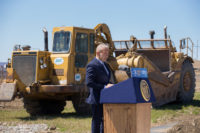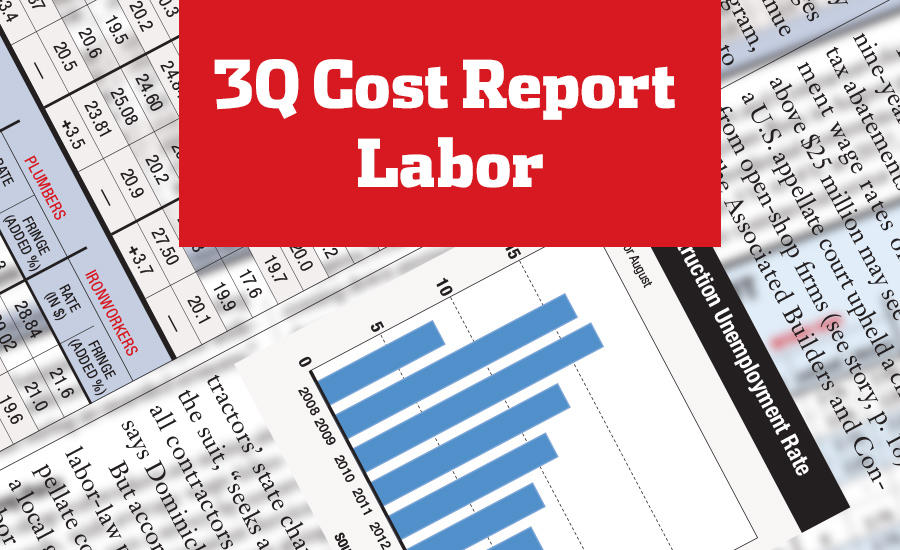Labor Gaps Bring Steady Pay Raises
AGC says half of contractors have boosted craft base pay, but issues are tense in some markets


PHOTO COURTESY OF TUDOR VAN HAMPTON


With construction activity at a high level in many parts of the U.S., a majority of contractors face a tight labor market. As some firms report offering higher wages to attract workers, craftworkers continue to see steady increases in base pay.
In August, the Associated General Contractors of America reported that 69% of construction firms are having a hard time filling hourly craft positions, according to its survey of 1,460 contractors. Craftworker shortages are the most severe in the Midwest, where 77% of contractors report having a hard time filling positions, says AGC. More than 70% in the South and West also report difficulties
Although more than two-thirds of surveyed firms have had trouble filling available positions this year, that demand is down from last year, when 86% of responding firms reported a tight labor market. Stephen Sandherr, CEO of AGC, said that between July 2015 and July 2016, construction employment expanded in 239 out of 358 metro areas, according to federal employment data.
|
Click to View the Third-Quarter Cost Report |
AGC added that 75% of firms say it will remain hard—or get harder—to find hourly craftworkers in the next 12 months. U.S. Bureau of Labor Statistics’ data show construction unemployment rates continuing to drop. Construction unemployment fell to 4.6% in June and 4.5% in July, the first time the rate dipped below 5% in nearly a decade. “These shortages have the potential to undermine broader economic growth by forcing contractors to slow scheduled work or choose not to bid on projects, inflating the cost of construction,” Sandherr said in a statement. To help address the tight labor market, nearly half of AGC’s surveyed construction firms increased base pay rates for craftworkers because of the difficulty in filling positions. In addition, at least 22% of the employers have improved employee benefits for craftworkers, and 20% report that they are providing incentives and bonuses to attract workers.
Union Pay Hikes Are Gradual
Despite promises of higher wages, increases in base pay have been gradual. For union labor, first-year settlements saw a 2.5% increase nationally in 2015, says the Construction Labor Research Council, which tracks collective-bargaining.
Executive Director Carey Peters says the first-year settlements in 2016 are tracking at about 2.8% through mid-September. That rate continues a gradual and steady upward trend in settlements since 2011, when they bottomed out at 1.7%. But the hikes remain well below previous levels, he points out. Before the recession, first-year settlements averaged 4.4% in 2007 and 4.6% in 2008.
While settlements for most trades remain close to the national average, Peters says electricians and plumber-pipefitters are trending above average this year, while bricklayers are below average. Settlements in the South Central region—Arkansas, Louisiana, New Mexico, Oklahoma and Texas—are trending above the national average, with other regions clustered around the national average, he adds.
The length of settlements also has increased. Peters says that, anecdotally, he has seen fewer one-year pacts and more multiyear ones. “We’re seeing five-year settlements now,” he says. “We’re a number of years removed from the Great Recession, so perhaps the bargaining parties are feeling more comfortable now with multiyear settlements than during an unsettled economy.”
Keeping Pace
Merit-shop craftworkers are seeing similar trends, with average wage hikes of 3.6% in 2015, says a survey by research firm Personnel Administration Services. It noted that contractors anticipate giving, on average, a 3.5% hike this year, although firms tend to report increase estimates conservatively, says PAS President Jeff Robinson. “Even level at 3.5%, that’s still ahead of what other industries are reporting,” which is about 3%, he adds. “The industry knows it has to pay to keep folks,” Robinson says.
The researcher also notes that construction wage increases outpace the federal BLS Employment Cost Index, which reported a 12-month, 2.4% increase for private industry workers between June 2015 and June 2016. Robinson says some analysts are predicting the index could top 3% by year-end. “Unless something drastic happens, I can’t see the [rate of increase] coming down anytime soon,” he adds. Industry economists’ predictions of an uptick in construction growth next year likely will further squeeze workforce costs. Associated Builders and Contractors chief economist Anirban Basu in August predicted that nonresidential construction spending will rise 3% to 4% in 2017, led by the private commercial sector and aided by some improvement in energy construction. The National Association of Home Builders forecasts low mortgage interest rates will enable residential construction growth, “but it will be constrained by shortages of labor and rising regulatory costs.”
New Rules
But changing labor cost dynamics will continue to fuel tension in wage and benefit negotiations in some key markets. Nearly 700 glaziers in July staged a three-week strike in Washington state’s booming Puget Sound area against the 13 contractors in the Western Washington Glass Contractors Multi-Employer Group, the first such action in 30 years, according to media reports. Members of glaziers’ union Local 188 rejected the employers’ final offer for an additional $8.50 in wages and benefits per hour over four years. But the strike was settled when the two sides agreed to an $8.00-per-hour raise over three years, Lisa Daroja, union business manager, told ENR. “The economy is doing well here,” she says. “We’re making up lost ground.”
In New York City, after months of negotiation in 2015, building trades and developers could not agree by a January deadline on a deal to set prevailing wages on residential construction to continue the city’s 421-a tax abatement program, a key catalyst for affordable housing to be built. The incentive was set to end if there were no deal by that date.
Gov. Andrew Cuomo (D) in August proposed a replacement, a new wage subsidy for large projects in Brooklyn and Queens, say real estate-sector media. But some of the city’s largest contractors have opted not to renew union collective bargaining, as nonunion firms make inroads in key private-sector building sectors, according to The Wall Street Journal last April.
In Jersey City, N.J., the future of a nine-year-old municipal rule tying city tax abatements to project-labor-agreement wage rates on private projects above $25 million may see changes after a U.S. appellate court upheld a challenge from open-shop firms.
The Associated Builders and Contractors’ state chapter, which brought the suit, “seeks a level playing field for all contractors to bid and win work,” says Dominick Mondi, president.
But according to Rutgers University labor-law professor Alan Hyde, the appellate court position “seems to be that a local government may require project labor agreements when it funds development, as the U.S. Supreme Court has held, but not when the funding comes by way of a tax abatement, instead of an appropriation. This is a pretty stupid line to draw, and there is no precedent supporting it.” Hyde adds, “The case now returns to the lower court [for review,] so the decision by itself will not have any impact on construction labor relations.”







